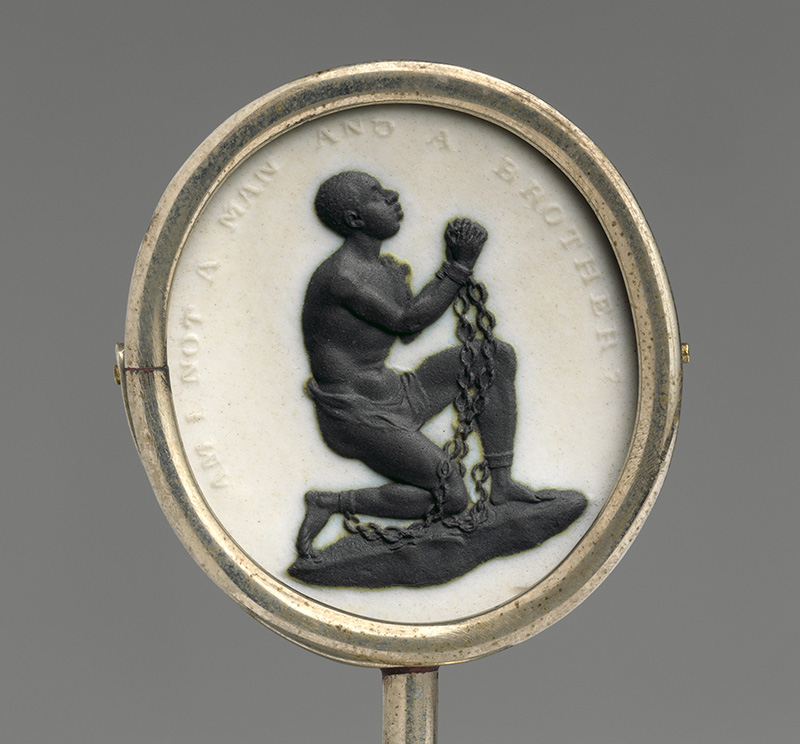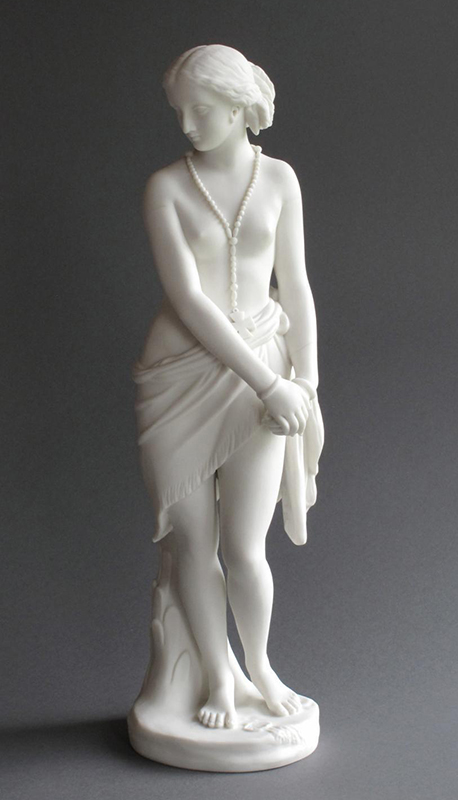Sculpture at the End of Slavery
by Caitlin Meehye Beach
In 1788, the Staffordshire potter Josiah Wedgwood mailed across the Atlantic a package of small jasperware medallions, each bearing a bas-relief of a kneeling Black man in chains encircled by the words, “Am I not a man and a brother?” (figure 1). They were destined to the headquarters of the Pennsylvania Anti-Slavery Society, and in an accompanying note to Benjamin Franklin, the society’s then-president, Wedgwood expressed his hopes that with these objects “the subject of freedom will itself be more canvassed and better understood.” 1 Franklin confirmed this to be true, writing of the medallions, “I am persuaded it may have an effect equal to that of the best written Pamphlet.”2
Published by the University of California Press this fall and generously supported by a Dean F. Failey Grant from the Decorative Arts Trust, Sculpture at the Ends of Slavery interrogates how a wide range of objects—from antislavery medallions to statues of bondspeople bearing broken chains—gave visual form to narratives about abolition in the 18th and 19th centuries. Centering analyses of work by Wedgwood, Hiram Powers, John Bell, Edmonia Lewis, and Francesco Pezzicar alongside close readings of archival materials and theoretical texts, this book sheds light on the complex and contradictory place of sculpture as it moved through a world contoured by the economy of slavery and international campaigns mounted to abolish it. If the medium was a highly visible means of interrogating the politics of slavery, so too was it a deeply unstable one: sculpture emerged from a world of aesthetic, political, and economic flux in which any vision of freedom proved challenging to articulate as visual and material fact.
This book accounts for the paradoxes of abolitionist imagery by demonstrating how the sculptural enterprise and medium overlapped with commerce and commodification under enslavement. First, sculpture’s production and circulation—a capital-intensive, increasingly industrial enterprise—was embedded in flows of global trade connected to American plantation economies. Second, its reception was shaped by contemporary considerations of bodily existence. Concerns with the lifelike nature of sculpted bodies carved from marble, cast in bronze, modeled from plaster, or fired in clay—long understood as measures of artistic virtuosity— were inextricable from hierarchies of race and subjectivity that shaped slavery’s regimes of bodily commodification. This central claim revises conventional art historical understandings of sculpture as both produced body and industrially made object. It also looks to contribute to interdisciplinary dialogues about race and justice by modeling a set of strategies for considering the possibilities and limitations of art in the pursuit of redress under capitalism.
The intertwined histories of sculpture and the decorative arts are central to the book’s approach. Case studies of makers including Josiah Wedgwood, John Bell, and Edmonia Lewis turn on the premise that these overlapping domains made possible new configurations for the circulation of antislavery imagery, each with widely differing impacts. The efficacy of Wedgwood’s famous antislavery medallions hinged upon the incorporation of a sculptural form—the kneeling slave—into a small cameo, and I explore the paradoxes behind the qualities of a handheld object that abolitionists believed to communicate “information and Evidence” against a trade “both impolitick and unjust.”3
The work of the English sculptor Bell, too, turned upon contradiction: the sculptor relied on collaborations with manufacturing firms like Elkington, Coalbrookdale, and Minton to reproduce works like A Daughter of Eve (The American Slave) and The Octoroon and draw attention to the cruelty of slavery in the British Atlantic (figures 2, 3, and 4). Yet the industrialist economies behind the production of Bell’s work meant that his depictions of captive figures were never far from the circuits of capital that supported the economy of slavery itself.
Finally, a chapter on Lewis explores the radical possibilities for sculpture and the decorative arts to effect change under capitalism. In Civil War-era Boston, the sculptor found important markets for her plaster statuettes and medallions at African American soldier’s relief fairs, where hand-crafted goods were central to care, mutual aid, and public belonging for Black women makers and activists.
The Trust’s Failey Grant generously supported the book’s image program, which includes photographs of work that have previously not been published, including meeting minutes from a Quaker antislavery society containing a preliminary illustration for the Wedgwood medallion, archival material and sketches related to the rotating pedestal for Hiram Powers’ Greek Slave, designs of Bell’s work for Coalbrookdale and Minton pattern books, and cartes-de-visite of Lewis’ plaster portrait bust of the Civil War hero Robert Gould Shaw. In shedding light on these and many other images, Sculpture at the Ends of Slavery seeks to expand understandings of how sculpture and the decorative arts have interfaced with the worlds of sculpture, industry, and manufacturing, as well as with broader circuits of racial capitalism and efforts towards racial justice.
- Josiah Wedgwood to Benjamin Franklin, 29 February 1788, Mss.B.F85, Benjamin Franklin Papers, American Philosophical Society.
- Franklin to Wedgwood, 15 May 1788, #3927-1, Benjamin Franklin Collection, Yale University Library.
- Meeting minutes, 22 May 1787, Minute books of the Committee for the Abolition of the Slave-trade, vol. 1, 22 May 1787–9 July 1798, Add MS 21254, British Library.
Caitlin Meehye Beach is an Assistant Professor of Art History at Fordham University.
A print version of this article was published in The Magazine of the Decorative Arts Trust, one of our most popular member benefits. Join today!



![Figure 2. John Bell for Minton, A Daughter of Eve [The American Slave] (1863) in Minton and Company, Catalogue of Shapes, 19th century, SD 1705/MS 1651. The Minton Archive/Fiskars, Ltd.](https://decorativeartstrust.org/wp-content/uploads/sculpture-2.jpg)

